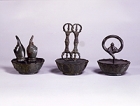Japanese Gallery (Honkan) Room 14
July 29, 2008 (Tue) - November 16, 2008 (Sun)
Nachisan (Mt.Nachi), located in Higashimuro-gun, Wakayama, is one of the Three Sacred Mountains of Kumano, with the Nachi Waterfall (also known as Ichinotaki) as its primary object of worship. At the area called Kareike, along the path leading to this waterfall, a large amount of objects related to Buddhism, including sculptural and engraved images of divinities and ritual implements, were unearthed in 1918 and 1930. About 70 sutra cases were found, suggesting that there were a large number of sutra mounds, where Buddhist scriptures and other related objects were buried to be preserved for the world to come after the long period of the decline of Buddhism.
Another noteworthy group of objects consists of Esoteric Buddhist statues and sanmayagyo (objects and mudras representing specific Esoteric Buddhist divinities) which form Jojin-e (the center section of the nine-sectioned Kongokai Mandala). Usually a mandala is painted on paper or silk, but in this case it is three-dimensionally represented using relief images of the divinities and of sanmayagyo resting on bowl-shaped lotus pedestals. This is the only example of such an object. The group also include Esoteric Buddhist implements, such as five kinds of ritual bells, vajras with a single prong, five prongs, or sacred jewel at each end, an incense burner, a set of six bowls, katsuma (a cross of vajras with three prongs), and shiketsu (four stakes on the four corners of an altar to rope off the sanctuary). These are believed to correspond to the items mentioned in "Nachisan Takimoto Kinkyomon Engi" written by Gyoyo in 1130, which is a record of his ascetic practices and a list of ritual implements he used to offer prayers to Buddha.
Other finds included a priest's staff which is associated with Shugen (Buddhism combined with mountain worship), Nara period gilt bronze Buddhist statues, 84,000 miniature stupas made by Jian Hong-chu of China in 955, and Japanese bronze mirrors from the Kamakura period.

